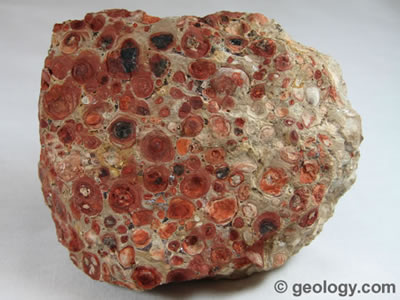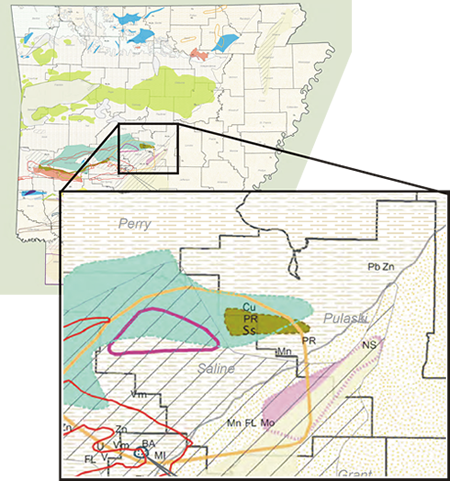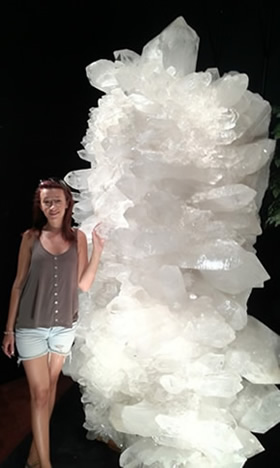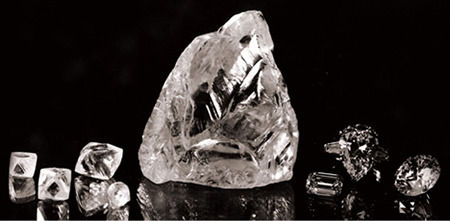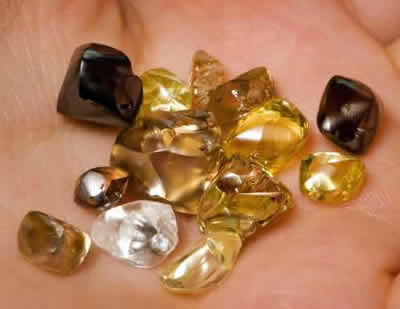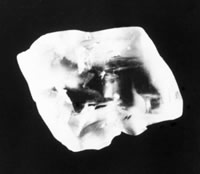Arkansas
Type |
Symbol |
Year Est. |
|---|---|---|
State Rock |
Bauxite |
1967 |
State Mineral |
Quartz Crystal |
1967 |
State Gemstone |
Diamond |
1967 |
State Dinosaur |
Arkansaurus fridayi |
2017 |
State Rock: Bauxite
ACT 128
AN ACT to Designate the Diamond the State Gem, Quartz Crystal the State Mineral, and Bauxite as the State Rock.
Be It Enacted by the General Assembly of the State of Arkansas:
SECTION 3. Bauxite is hereby adopted and designated the official State Rock of the State of Arkansas.
SECTION 4. It is hereby found and determined by the General Assembly that there is presently no officially designated State Gem, State Mineral or State Rock, for the State of Arkansas; that there are many clubs and individuals throughout the United States that collect, trade, and sell official State Gems, Minerals and Rocks, and that it is essential that the General Assembly immediately designate a State Gem, Mineral and Rock, in order that the various interested clubs and individuals in Arkansas can trade official State Gems, Minerals and Rocks, with like clubs and individuals in other States. Therefore, an emergency is hereby declared to exist and this Act being necessary for the preservation of the public peace, health and safety, shall be in effect from the date of its passage and approval.
Bauxite is a sedimentary rock, which is usually produced when most of the minerals are leached from the soil leaving high levels of alumina behind in wet tropical or subtropical environments. Bauxite is often thought of as an aluminum mineral (that is even how it was present in several intro geology labs I was in charge of) however it isn't just one mineral; bauxite is primarily composed of gibbsite (Al(OH)3), boehmite (AlO(OH)), and diaspore (AlO(OH)). All of these minerals are extremely soft, occurring between 1 and 3 on Moh's Hardness Scale, meaning bauxite itself is a soft rock. The formation of bauxite produces a pissolitic texture, which resembles little balls glued together (as seen in the picture to the left). The majority of the aluminum in the world comes from bauxite ores. To extract the aluminum from the bauxite, the bauxite is crushed into a powder and the aluminum is leached out via several chemical procedures. The obvious use of aluminum is as a metal, but it can also be used for abrasives (one of the by-products of the leaching process has a hardness on Moh's scale of 9), in cements, and as proppants (high density spherical grains used by the oil and gas industry in fracking). Currently, the United States is not even in the top ten for bauxite producers and it is only found in a handful of localities in the United States (Arkansas, Georgia, and Alabama).
Mineral resources of Arkansas, highlighting the Bauxite deposits, which are the light pink areas. Map courtesy of the Arkansas Geological Survey.
Arkansas bauxite was formed from richly alkaline igneous intrusive rocks that intruded into the Paleozoic age sedimentary rocks of the central region of Arkansas. The weathering of these igneous intrusive rocks during the Eocene provided the material to form the bauxite deposits. The igneous rock intrusion is a complex series that includes bodies of nepheline syenite and porphyritic alkalic syenite, as well as dikes and border phases of related rocks. These rock strike towards the northeast of Arkansas and dip gently towards the southeast. The bauxite is found within two regions of Arkansas, covering 275 square miles, located within Pulaski and Saline Counties. These are mapped on Mineral Resources map (to the right). Bauxite deposits are highlighted by the pink areas covering the two counties. In Arkansas, bauxite production started in 1899, and increased until 1923 when Arkansas produced half of the world's supply at 500,000 tons that year. The peak of production was in 1943 when 6,000,000 long tons were produced, but it has had a steady decline ever since. In 1982, mining of bauxite was ceased for aluminum metal with the current bauxite mining being used primarily for the production of proppants.
State Mineral: Quartz Crystal
ACT 128
AN ACT to Designate the Diamond the State Gem, Quartz Crystal the State Mineral, and Bauxite as the State Rock.
Be It Enacted by the General Assembly of the State of Arkansas:
SECTION 2. Quartz crystal is hereby adopted and designated the official State Mineral of the State of Arkansas.
SECTION 4. It is hereby found and determined by the General Assembly that there is presently no officially designated State Gem, State Mineral or State Rock, for the State of Arkansas; that there are many clubs and individuals throughout the United States that collect, trade, and sell official State Gems, Minerals and Rocks, and that it is essential that the General Assembly immediately designate a State Gem, Mineral and Rock, in order that the various interested clubs and individuals in Arkansas can trade official State Gems, Minerals and Rocks, with like clubs and individuals in other States. Therefore, an emergency is hereby declared to exist and this Act being necessary for the preservation of the public peace, health and safety, shall be in effect from the date of its passage and approval.
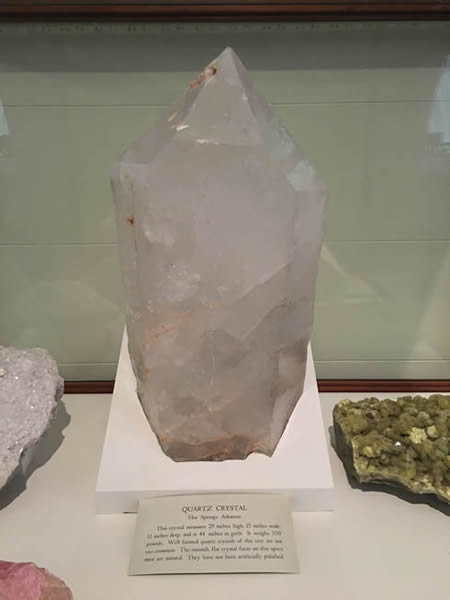
Quartz crystal from Hot Springs, Arkansas located at the Chicago Field Museum. Image by myself.
Quartz is one of the most common minerals on Earth, primarily due to its simple structure and chemical formula, SiO2. Quartz also has an extremely high hardness, 7 on Mohs hardness scale, meaning that it doesn't scratch very easily and therefore does not break down easily. As the rocks on Earth are slowly eroded over time, most of the other minerals will break down into clay while quartz grains will generally just gets smaller and smaller. The result is that most beach sand is composed of quartz that has a slight hematite (rust) stain to it to give the sand grains their slight yellowish color. Although quartz is a simple mineral, it can come in a variety of colors depending on what type of impurities are present in the crystal structure; pure quartz crystal is clear, milky quartz is white, smoky quartz is grey, amethyst is purple quartz, citrine is yellow quartz, rose quartz is pink, as well as some other colors and varieties. Quartz does not have any cleavage, meaning that when it breaks it doesn't form along perfect surfaces. Instead as the quartz crystals grow, individual mineral molecules of quartz are added to the outside of the crystal from water rich in dissolved SiO2 or mineral melt (liquid rock like lava or magma).
Worlds largest quartz crystal, mined at Old Coleman Mine in Jessieville, Arkansas. Image courtesy of allthingsarkansas.com.
Although the mineral quartz is the most common mineral on the surface of the Earth, quartz crystals are a little rarer. The deep running hydrothermal waters in Arkansas, which had made the town of Hot Springs famous, have produced some of the finest varieties of quartz crystals on the planet. The Ouachita Mountains, home to the hot springs, has been known for centuries by Native Americans for their beautiful quartz crystals that were considered to have spiritual and sacred significance. The Ouachita Mountains began to be formed 600 million years ago, when a local rift basin started to open up. This rift basin accumulated sediment that eventually formed into sandstone and shale. These deposits were subsequently uplifted producing the mountain complex. Hydrothermal fluids started circulating through these rocks approximately 245 million years ago producing silica rich fluids that precipitated the quartz veins within cracks in these rocks. Native American artifacts from these rock crystals date back to 9,000 BC., with many of the early Native American arrow tips being fashioned from the quartz crystals themselves. In the modern days, these quartz crystals are considered to be some of the most beautiful quartz crystals in the world. People travel from all over to go to Mount Ida and Hot Springs to the many "dig your own quartz crystal" mines. The town Mount Ida even proclaims itself the "Quartz Crystal Capitol of the World". Currently, there has been an estimated 1,200 tons of quartz crystal ever mined from this region, totalling approximated 5% of the estimated total quartz crystal reserves. There is still plenty of quartz crystals left to be mined, perhaps finding one larger than the current world's largest quartz crystal, which was mined from the Old Coleman Mine in Jessieville, Arkansas (pictured left).
Related: Alabama State Gemstone - Star Blue Quartz; Georgia State Gemstone - Quartz; New Hampshire State Gem - Smokey Quartz; South Carolina State Gem Stone - Amethyst; South Dakota State Mineral Stone - Rose Quartz
State Gemstone: Diamond
ACT 128
AN ACT to Designate the Diamond the State Gem, Quartz Crystal the State Mineral, and Bauxite as the State Rock.
Be It Enacted by the Geneml Assembly of the State of Arkansas:
SECTION 1. The Diamond is hereby adopted and designated the official State Gem of the State of Arkansas.
SECTION 4. It is hereby found and determined by the General Assembly that there is presently no officially designated State Gem, State Mineral or State Rock, for the State of Arkansas; that there are many clubs and individuals throughout the United States that collect, trade, and sell official State Gems, Minerals and Rocks, and that it is essential that the General Assembly immediately designate a State Gem, Mineral and Rock, in order that the various interested clubs and individuals in Arkansas can trade official State Gems, Minerals and Rocks, with like clubs and individuals in other States. Therefore, an emergency is hereby declared to exist and this Act being necessary for the preservation of the public peace, health and safety, shall be in effect from the date of its passage and approval.
The Cullinan Diamond, which was polished into nine large diamonds and many more smaller diamonds. Image courtesy of The Cape Town Diamond Museum.
One of the most famous gemstones, the diamond, is also one of the hardest minerals on earth (it is actually the third hardest after two extremely rare minerals called Wurtzite Boron Nitride and Lonsdaleite (Newscientist.com)). A diamond is made up entirely of carbon (like its mineral cousin graphite), where the arrangement of the carbon atoms and the strength of the bonds are what give the two minerals completely different properties. Diamonds are measured in carats, where a carat is equal to 200 milligrams. Diamonds range in size from the microscopic diamond dust to the largest diamond ever discovered, the Cullinan Diamond, weighing in at 3106 carats, or ~1.4 pounds. The Cullinan Diamond (pictured right) was eventually cut into over 100 separate stones, with two of the largest stones forming part of the Crown Jewels. Diamonds are most often found in structures called kimberlites or lamproites. Kimberlites are magmatic rocks that are formed deep within the Earth. The high pressure converts the carbon into diamonds and the structures make their way to the surface as buoyant globs of rock. Due to being formed at such high pressure, diamonds are inherently unstable on the Earth's surface, however they degrade at such a slow rate that it isn't much of an issue in jewelry. Many diamonds today are found in these isolated structures, however not many kimberlites or lamproites are known to exist within the United States, with only two knowingly existing.
Some of the diamonds found at Crater of Diamonds State Park in Arkansas. Image courtesy of Arkansas State Parks.
The Uncle Sam Diamond, which was the largest diamond every found in the United States. It was found in the location which eventually became Crater of Diamonds State Park, Arkansas. Image courtesy of diamondshop09.blogspot.com.
The main locality for finding diamonds in the US is a lamproite located in Crater of Diamonds State Park, Arkansas. Here visitors are allowed to mine for diamonds and keep what they find (as pictured above); the only such diamond mine on Earth. It was originally assumed that the diamonds in Arkansas were formed from a kimberlite, however recent research has shown that lamproites, which differ from kimberlites in how they are formed and in their chemistry, more closely align with the deposits in Arkansas. Generally, the diamonds found within Arkansas have a tendency to be smaller in size than their counterparts in Africa. However, there have been some significant finds including the the largest diamond ever found in North America, called "The Uncle Sam". The Uncle Same was discovered in 1924 and weighed 40.42 carats before it was cut (pictured right).
State Dinosaur: Arkansaurus fridayi
HCR 1003
HOUSE CONCURRENT RESOLUTION
TO DESIGNATE THE ARKANSAURUS FRIDAYI AS THE OFFICIAL STATE DINOSAUR.
WHEREAS, for public and educational benefits, the Ninety-First General Assembly of the State of Arkansas will select an official state dinosaur from the known population of dinosaurs represented in Arkansas's fossil record: Arkansaurus, sauropod dinosaur, and theropod dinosaur tracks of currently uncertain taxonomic affiliation; and
WHEREAS, from these species, the Arkansaurus fridayi shall be selected, since it is unique to the State of Arkansas, brings recognition to the State of Arkansas, and promotes an interest paleontology in Arkansas; and
WHEREAS, by designating an official state dinosaur, Arkansas would join nine (9) other states in the country with a unique designation of an official state dinosaur; and
WHEREAS, the Arkansaurus fridayi was discovered in a gravel pit near the community of Lockesburg, Arkansas, in August 1972 by Joe B. Friday and studied by Professor James Harrison Quinn of the University of Arkansas in 1973 and by paleontologist ReBecca Hunt since 2003, and the official recognition of this dinosaur would provide valuable research and educational opportunities in our state; and
WHEREAS, the State of Arkansas shall declare an official state dinosaur for the first time in its history and for the tenth time in the history of the United States of America; and
WHEREAS, the State of Arkansas recognizes that "Arkansaurus fridayi" remains, for now, the unofficial name of the dinosaur; and
WHEREAS, Arkansaurus fridayi shall be selected to represent the State of Arkansas in the small community of State Dinosaurs in the United States,
NOW THEREFORE,
BE IT RESOLVED BY THE HOUSE OF REPRESENTATIVES OF THE NINETY-FIRST GENERAL ASSEMBLY OF THE STATE OF ARKANSAS, THE SENATE CONCURRING THEREIN:
THAT the House of Representatives recognizes and designates the Arkansaurus fridayi as the official dinosaur of Arkansas.
BE IT FURTHER RESOLVED that upon adoption of this resolution, an appropriate copy shall be provided to the Arkansas Geological Survey, the University of Arkansas Department of Geosciences, and the mayor of Lockesburg, Arkansas, by the Chief Clerk of the House of Representatives.
Cast of the reconstructed Arkansaurus fridayi material.
Photo courtesy of ReBecca Hunt-Foster.
Besides fragmentary bits of bones and some dinosaur tracks, Arkansaurus fridayi is the only known dinosaur fossil recovered from the state of Arkansas to date. The fossil was initially discovered by Joe B. Friday on his land in 1972 during an earthmoving project. The fossil comprised of bones from the right foot of the animal. They were discovered within the Early Cretaceous Trinity Group (Albian-Aptian, ~113 million years ago) near Locksburg, Arkansas. These bones were initially described back in 1973, however not much else was done with the fossil material until 2018 when they were redescribed by Hunt and Quinn as a new species of ornithomimosaur (the kind of dinosaurs you saw running around in flocks on Jurassic Park). The remains of Arkansaurus were compared to other known dinosaurs and determined to be an early relative of the Late Cretaceous ornithomimids Ornithomimus and Struthiomimus. Ornithomimids are usually identified by their resemblance to modern day ostriches (hence the name "ornithomimid" means "ostrich mimic"), and the bones of Arkansaurus were similar enough to the known ornithomimids to declare it as an early ancestor of those species. The genus name Arkansaurus means "Arkansas' reptile" and the species name fridayi was in honor of Joe B. Friday, who initially discovered the remains.
References
https://statesymbolsusa.org/states/united-states/arkansas
http://www.soskids.ar.gov/pdfs-09/Arkansas_State_Symbols.pdf
https://thebauxiteindex.com/en/cbix/industry-101/bauxite-101/bauxite-formation
https://www.geology.arkansas.gov/minerals/industrial/bauxite.html
http://geology.com/minerals/bauxite.shtml
http://www.geology.arkansas.gov/pdf/pamphlets/Bauxite.pdf
https://www.geology.arkansas.gov/docs/pdf/education/mineral-resources-poster.pdf
https://www.arkansas.com/articles/quartz-crystals
https://www.arkansas.com/mount-ida
http://www.arkansas.com/things-to-do/crystal-hunting/
http://www.rockngem.com/arkansas-quartz-origin-and-history/
https://pubs.usgs.gov/pp/0299/report.pdf
http://www.bluemooncrystals.com/Crystal_Mining.html
http://rockhoundingar.com/feepay.php
http://www.soskids.ar.gov/5-8-history-state-symbols.html
https://www.allthingsarkansas.com/weekly-blog-about-all-things-arkansas/quartz-crystal-in-arkansas
https://4cs.gia.edu/en-us/diamond-carat-weight/
http://www.newscientist.com/article/dn16610-diamond-no-longer-natures-hardest-material.html
http://www.sciencedaily.com/releases/2012/01/120123094523.htm
http://www.geology.ar.gov/pdf/pamphlets/AGES%20BROCHURE-DIAMONDS%2011-13-07.pdf
http://m.encyclopediaofarkansas.net/media/detail/?mediaID=6544
http://www.capetowndiamondmuseum.org/blog/2017/04/top-8-largest-diamonds-in-the-world/
https://link.springer.com/article/10.1134/S0869591111010024
https://geology.com/articles/crater-of-diamonds/
http://diamondshop09.blogspot.com/2009/06/uncle-sam-diamond.html
http://dontmesswithdinosaurs.com/
https://www.arkleg.state.ar.us/Bills/FTPDocument?path=%2FBills%2F2017R%2FPublic%2FHCR1003.pdf
Geology of Arkansas's National Parks
Through Pictures
(at least the one's I have been to)
Visited in 2003
.jpg)
The water within Hot Springs National Park is unique in that it has traveled a very long way down into the ground surface. These waters have been heated up by geothermal activity (the heat inside the Earth) as opposed to the volcanic activity that you would see at springs in areas like Yellowstone. Here is Bathhouse Row, where the bathhouses are lined up along the areas where the natural springs come to the surface.
.jpg)
Since the water has been heated by geothermal activity, none of the nasty chemicals associated with volcanic hot springs are present in these waters. That makes it so these waters are able to not only be bathed in, such as at the bathhouse.
.jpg)
But also you can drink the water, such as at one of the free hot spring fountains.
.jpg)
Although, many of the bathhouses obscure the natural emergence points of the hot springs, some of the natural springs can still be seen along the area, such as this spring adjacent to Bathhouse Row.



